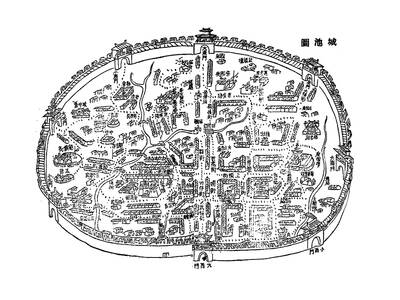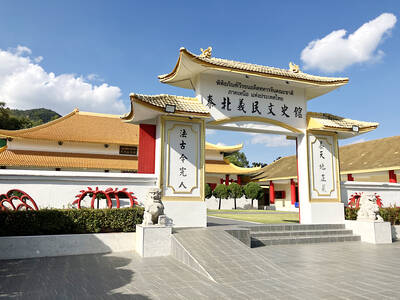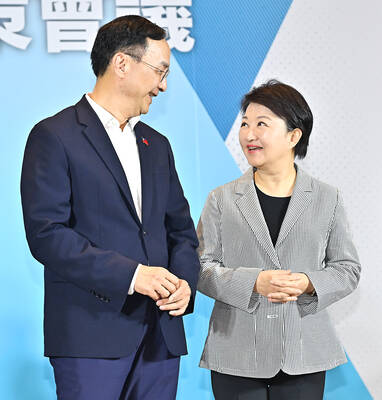Located near Taipei Train Station, Ri Xing Typography (日星鑄字行) looks like any of the other unprepossessing workshops and offices on its small side street. But the tiny factory houses one of Taiwan’s treasures — the last complete set of traditional Chinese character molds for lead-type casting in the world.
The lead type is used for movable type, a printing process that has been largely superseded by newer techniques. So Chang Chiehkuan (張介冠), whose parents founded Ri Xing Typography in 1969, plans to bring his family’s legacy into the 21st century by digitizing Ri Xing’s typefaces and turning the factory into a museum.
“Our most important goal right now is to preserve our industry by letting people come here and experience movable type for themselves. That’s our biggest dream,” says Chang.
Ri Xing Typography is one of the last factories in Taiwan to produce traditional Chinese character lead type (the other, Chung Hsing Typography (中新鑄字行) in Kaohsiung, was founded by Chang’s uncle). The facility looks much as it did 40 years ago. A steady, rhythmical thumping emanates from its type-casting machines and flows through rows of shelves upon which thousands of pieces of lead type, representing every Chinese character and dozens of symbols, are stacked.
Movable type may be 1,000 years old (and Chinese characters are, of course, much older than that), but Chang hopes that he can make the printing method relevant to a new generation by turning Ri Xing lead type into computer fonts and making the typefaces compatible with newer printing methods. The digitization is one part of Ri Xing Typography’s restoration and preservation plan (日星鑄字行活版字體復刻暨保存計畫) Chang launched last fall. The second part is turning the factory into a museum where visitors can experience movable type hands on.
The project is a monumental one and Chang expects it will take at least 10 years to complete. Ri Xing’s lead type comes in three different fonts, most of which are available in seven different sizes, giving Ri Xing a total collection of a whopping 200,000 molds. Chang estimates it will take two to three years just to scan, upload and edit every character.
His dedication is spurred on by the fact that Taiwan is the last country in the world to use traditional Chinese characters as its standard writing system. And he believes Ri Xing’s lead type, made from molds that were originally hand-carved, captures the spirit of Chinese writing better than computer fonts.
Normally laid-back, Chang becomes effusive when showing visitors charts comparing characters printed with the shop’s kaishu (楷書, or standard script, a style of Chinese calligraphy) lead type and a font found in most word processing programs. (The two other styles available as lead type in Rixing are songti (宋體), a non-calligraphic font, and the bold heiti (黑體).)
“I think that when you compare them side by side, you can see right away that words printed with lead type are much lovelier because they are able to preserve the beauty of Chinese calligraphy and the grace of its individual brush strokes. Right now that is something you can’t find in computer fonts, in our opinion,” says Chang, who grew up surrounded by printing presses. “My parents have worked in this industry for 70 years, so I was immersed in it as soon as I was born. As a result, I feel very deeply about type.”
Chang’s ultimate goal may be to transform Ri Xing into a museum, but it is still an active business with clients, many of whom have ordered lead type from the factory for decades. Ri Xing’s customers are usually smaller print shops that produce specialty items, such as movie tickets or forms with serial numbers. Their proprietors dug their heels in two decades ago when Taiwan’s printing industry began to abandon movable type in favor of faster methods like offset printing.
“These older business people didn’t want to follow the rest of the industry and change what they were doing. They still use movable type, so I stay here and work with them so they can get the supplies they need,” says Chang.
Now Ri Xing Typography is garnering a new, but equally dedicated, group of supporters. Many of these fans are graphic designers who were drawn by media reports on Ri Xing. Some now volunteer with the digitization project, including Mu-han Chiu (邱睦涵), a freelance designer who first saw photos of Ri Xing’s lead type online.
“It is important to our culture. Taiwan and Hong Kong are the last places to actually use traditional Chinese character typeface, and it would be a shame to let this ancient form of writing disappear,” says Chiu. The 30 or so volunteers aren’t just designers, she adds — they include computer programmers and a bookstore owner.
“There are a lot of people who are passionate about this project,” says Chiu.
The Ri Xing plan is still a long way from being realized, but it has already received a fair amount of publicity in the Taiwanese media, thanks in part to a visit to the factory by President Ma Ying-jeou (馬英九) in June. Ri Xing is open to visitors for a few hours each week, and individual lead type can be purchased for NT$1 to NT$80 per piece. Its gifting potential is increased by the fact that the Taiwanese pronunciations of lead type (鉛字) and the fate that draws people together (緣份) sound alike.
“Chinese characters have a very long history and they are always evolving,” says Chang. “As long as they keep transmitting culture and knowledge, as well as their own individual meanings, then they are already fulfilling their purpose. It doesn’t matter what they look like, but we think lead type really brings out their beauty.”

May 26 to June 1 When the Qing Dynasty first took control over many parts of Taiwan in 1684, it roughly continued the Kingdom of Tungning’s administrative borders (see below), setting up one prefecture and three counties. The actual area of control covered today’s Chiayi, Tainan and Kaohsiung. The administrative center was in Taiwan Prefecture, in today’s Tainan. But as Han settlement expanded and due to rebellions and other international incidents, the administrative units became more complex. By the time Taiwan became a province of the Qing in 1887, there were three prefectures, eleven counties, three subprefectures and one directly-administered prefecture, with

It’s an enormous dome of colorful glass, something between the Sistine Chapel and a Marc Chagall fresco. And yet, it’s just a subway station. Formosa Boulevard is the heart of Kaohsiung’s mass transit system. In metro terms, it’s modest: the only transfer station in a network with just two lines. But it’s a landmark nonetheless: a civic space that serves as much more than a point of transit. On a hot Sunday, the corridors and vast halls are filled with a market selling everything from second-hand clothes to toys and house decorations. It’s just one of the many events the station hosts,

Among Thailand’s Chinese Nationalist Party (KMT) villages, a certain rivalry exists between Arunothai, the largest of these villages, and Mae Salong, which is currently the most prosperous. Historically, the rivalry stems from a split in KMT military factions in the early 1960s, which divided command and opium territories after Chiang Kai-shek (蔣介石) cut off open support in 1961 due to international pressure (see part two, “The KMT opium lords of the Golden Triangle,” on May 20). But today this rivalry manifests as a different kind of split, with Arunothai leading a pro-China faction and Mae Salong staunchly aligned to Taiwan.

Two moves show Taichung Mayor Lu Shiow-yen (盧秀燕) is gunning for Chinese Nationalist Party (KMT) party chair and the 2028 presidential election. Technically, these are not yet “officially” official, but by the rules of Taiwan politics, she is now on the dance floor. Earlier this month Lu confirmed in an interview in Japan’s Nikkei that she was considering running for KMT chair. This is not new news, but according to reports from her camp she previously was still considering the case for and against running. By choosing a respected, international news outlet, she declared it to the world. While the outside world